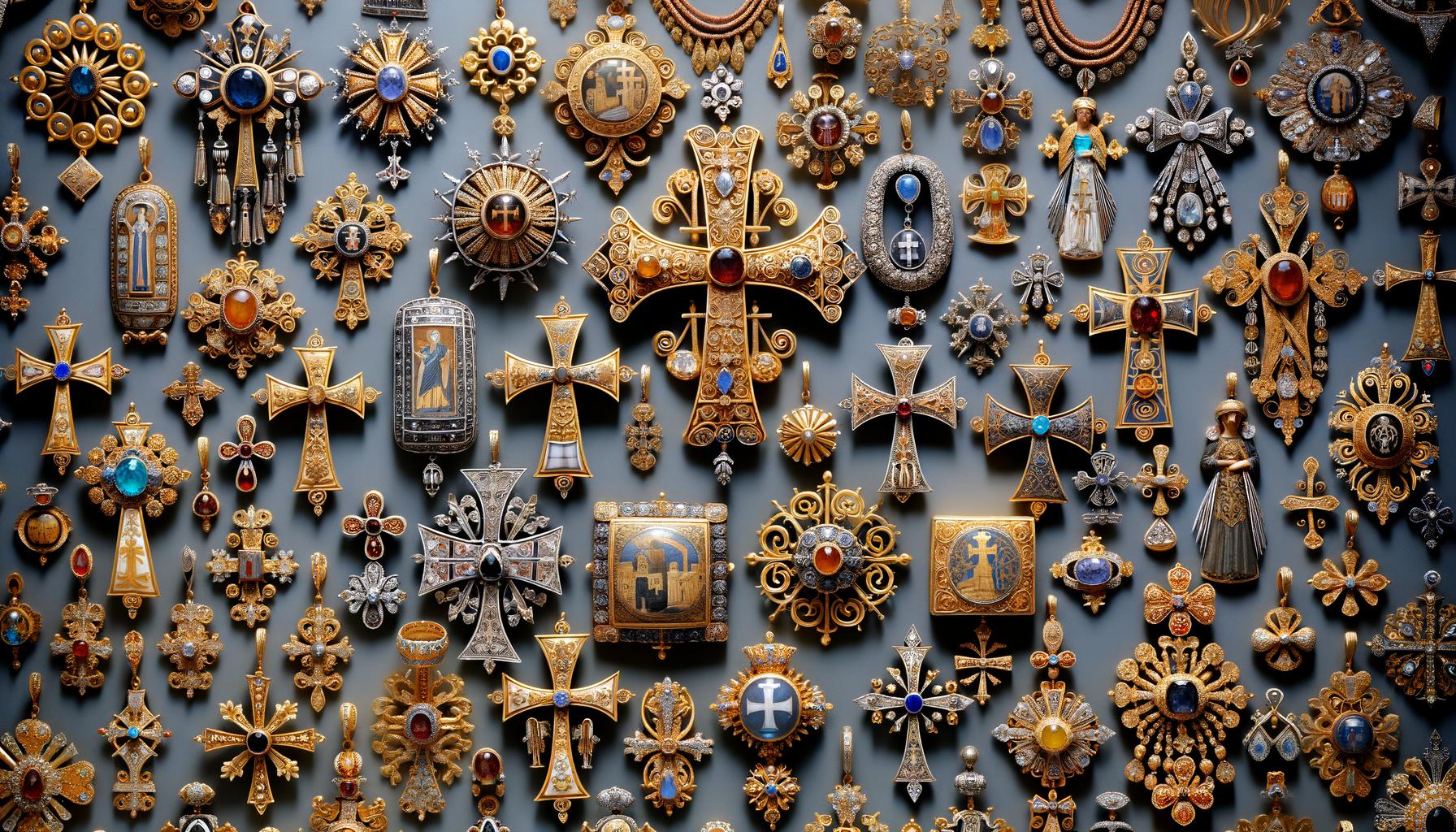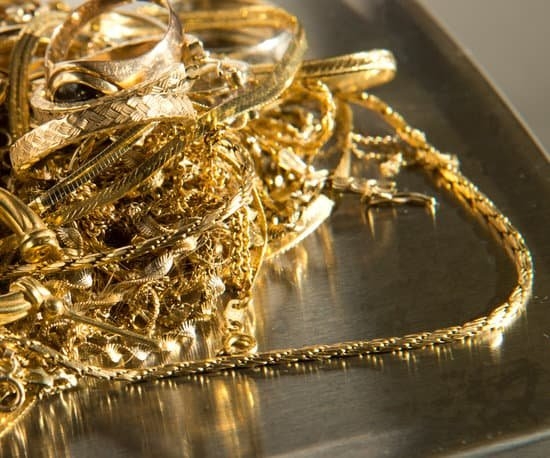The Byzantine Empire, also known as the Eastern Roman Empire, was a powerful and culturally rich civilization that thrived from approximately 330 AD until the Fall of Constantinople in 1453. Jewelry in the Byzantine Empire: religious and political symbols were not merely ornamental; they transcended their aesthetic utility to become potent emblems of faith, power, and status.
As the capital of Constantinople became a crucial hub for art, culture, and religion, jewelry evolved into an essential medium for showcasing religious devotion and political allegiance.
In the highly stratified society of Byzantium, wearing elaborate pieces often signified an individual’s wealth and position. From emperors adorned with jeweled crowns emblematic of divine right to common people donning faith-inspired amulets, jewelry held deep-seated meanings that went beyond personal adornment. Using precious materials like gold and gemstones alongside intricate craftsmanship techniques, these pieces served as both spiritual icons and markers of political authority.
This article delves into several key aspects related to jewelry in Byzantium: its historical roots stemming from earlier Roman influences; the materials and methods used by skilled artisans; how religious beliefs permeated designs; representations of imperial power through specific symbols; social hierarchy indicators embedded in adornments; distinctions between male and female pieces; issues of preservation today; and finally, its enduring influence on modern jewelry design.
By exploring these facets, we gain a comprehensive understanding of how jewelry functioned as an integral part of Byzantine life-a testament to their complex intersection of piety and politics.
Historical Context of Jewelry in the Byzantine Empire
The Origins and Continuity From Roman Influence
The Byzantine Empire emerged from the eastern part of the Roman Empire after its division in AD 395. This transition brought with it a wealth of cultural and artistic heritage, prominently reflected in the empire’s exquisite jewelry.
As Byzantium stepped into its role as a successor to Rome, it inherited not only administrative systems but also artistic traditions. The Roman penchant for opulent adornments found new life and expression in Byzantine jewelry, which expertly combined Greek, Roman, Persian, and Christian elements to form unique pieces that were both luxurious and symbolically rich.
The Evolution of Jewelry Over Time
Over centuries, Byzantine jewelry underwent significant evolution, influenced by the changing political landscape and religious transformations within the empire. During the early periods, much of Byzantine jewelry primarily mirrored late Roman styles characterized by intricate goldsmithing and use of semi-precious stones.
However, as Eastern Orthodox Christianity became more entrenched as the state religion under Emperor Constantine I, jewelry began to reflect more distinctly Christian iconography. Entire workshops dedicated themselves to crafting pieces that embodied religious devotion while simultaneously declaring their wearers’ social standings and allegiance to imperial power.
Impactful Historical Events on Jewelry Design
The varied historical events in Byzantium notably influenced jewelry design and usage throughout its duration. For instance, during times of military triumphs or diplomatic successes, there was often an influx of exotic materials such as sapphires from Sri Lanka or silks from China via trade routes stretching across continents – all contributing to increasingly sophisticated designs. Conversely, during periods like the Iconoclastic Controversy (726-843 AD), religious depictions on jewelry saw significant curtailment due to imperial decrees against religious images.
Such socio-political shifts clearly demonstrate how amid triumphs and turmoils alike, jewelry in the Byzantine Empire served as resilient symbols adapted to new religious meanings or reaffirmed existing political orders. The continuity yet evolution in these pieces provide critical insights into understanding broader historical currents within this illustrious empire.
Thus punctuated by pivotal moments and influenced by a confluence of diverse cultures,”jewelry in the byzantine empire: religious and political symbols” offers a fascinating lens into understanding not merely aesthetic choices but tangible reflections of cultural dynamism within one formidable chapter of human civilization.
Materials and Craftsmanship
Byzantine jewelry was renowned for its exquisite materials and intricate craftsmanship. Commonly used materials included gold, silver, and an array of precious stones like emeralds, sapphires, and pearls. The wealth of the empire allowed gold to become a staple in their jewelry creations, symbolizing both divine favor and earthly power.
Silver was also frequently employed, often adorned with gilding or enamelwork to enhance its appearance. Jewelry from this period was not just about adornment but also served as potent symbols of religious devotion and political authority.
Techniques and methods employed by Byzantine craftsmen were highly advanced for their time, showcasing an exceptional level of artistry and innovation. Filigree work, which involves the delicate manipulation of fine gold or silver wires to create intricate designs, was particularly popular.
Enameling techniques such as cloisonné allowed craftsmen to introduce vibrant colors into their pieces by filling compartments with molten glass or ceramic material that hardened upon cooling. These methods demonstrated a high degree of technical skill that set Byzantine jewelry apart from other periods.
The influence of trade routes on Byzantine jewelry designs cannot be overstated. As the crossroads between East and West, Byzantium benefited immensely from imported materials that enriched their local artisans’ palettes. Stones like amethysts from Egypt and garnets from India found their way into Byzantine creations, adding exotic flair to traditional designs. Notably, the Silk Road facilitated not just the exchange of goods but also the transmission of artistic techniques and styles from Persia, India, and even China.
| Material | Properties |
|---|---|
| Gold | Symbolizes divine favor and earthly power |
| Silver | Often adorned with gilding or enamelwork |
| Precious Stones (Emeralds, Sapphires) | Adds vibrancy; sourced via trade routes |
Understanding the use of these materials offers valuable insight into how jewelry in the Byzantine Empire: religious and political symbols were crafted to influence perception through opulence and rarity. The complex blend of local traditions with external influences created a unique visual language that communicated multifaceted messages about faith, loyalty, and power through every piece.
Religious Symbolism in Byzantine Jewelry
Byzantine jewelry was steeped in religious symbolism, reflecting the empire’s strong Christian ethos. One prominent example is the use of the cross, a powerful emblem of faith and devotion. Crosses were meticulously crafted from precious materials like gold and studded with gemstones, often worn as pendants or incorporated into brooches.
These items served not only as personal expressions of piety but also as public declarations of one’s faith. The early adoption and widespread use of such symbols in jewelry reveal how deeply intertwined religion was with everyday life in the Byzantine Empire.
Another notable religious motif frequently found in Byzantine jewelry is the ichthys or fish symbol, representing Jesus Christ. This ancient Christian symbol was subtly integrated into rings, earrings, and amulets, sometimes accompanied by inscriptions that conveyed blessings or prayers. Angels were also commonly depicted, serving as guardians or messengers from God. Angelic imagery on jewelry pieces provided spiritual protection to the wearer, embodying both aesthetic elegance and profound religious significance.
Distinctive pieces like enkolpia (cross-shaped reliquaries) contained holy relics and were worn around the neck as powerful talismans. These items facilitated a direct connection between the faithful and divine entities, underscoring their devotional purpose beyond mere adornment. Jewelry in the Byzantine Empire: religious and political symbols are evident through these artifacts that illustrate how belief systems sculpted artistic expression during this era.
| Religious Symbol | Description |
|---|---|
| Cross | A central symbol of Christianity used prominently in pendants and brooches. |
| Ichthys (Fish) | An ancient Christian symbol representing Jesus Christ, subtly integrated into various jewelry designs. |
| Angels | Depictions served as spiritual protectors and embellished rings, amulets, and necklaces. |
Political Symbols and Their Significance
In the Byzantine Empire, jewelry served as a visible manifestation of power and authority, intricately woven into the fabric of political life. The use of imperial portraits on rings, pendants, and medallions symbolized the profound connection between the ruler and his subjects. These pieces often featured elaborate designs incorporating likenesses of emperors, empresses, and other significant political figures, thus serving as both personal adornments and public declarations of loyalty to the reigning sovereign.
The double-headed eagle is one of the most iconic examples of political symbolism in Byzantine jewelry. This emblem represents the dual sovereignty over both secular and religious spheres that characterized the Byzantine emperor’s rule. Jewelry featuring this exquisite motif was worn by members of the imperial family and high-ranking officials to signify their close association with imperial power. The intricate craftsmanship involved in creating such pieces further emphasized their exclusivity and importance within the hierarchy.
Additionally, inscriptions were commonly used to imbue jewelry with political significance. Emperors would commission pieces with engraved texts that proclaimed their divine right to rule or documented key victories and achievements.
These inscriptions not only commemorated historical events but also reinforced the ruler’s legitimacy and divine favor in a tangible form that could be carried or worn by trusted individuals within the inner circles of power. Thus, jewelry in the Byzantine Empire: religious and political symbols was not merely decorative but played an essential role in maintaining and displaying authority across different strata of society.
Jewelry as Status Symbols
In the Byzantine Empire, jewelry was not merely decorative; it served as an unequivocal display of social status and wealth. High-ranking officials and members of the imperial family wore opulent pieces to signify their elevated positions within society. Jewelry in the Byzantine Empire: religious and political symbols often incorporated intricate designs that showcased both rank and influence, making it easy to distinguish between different societal classes.
Byzantine court ceremonies were grand affairs where jewelry played a pivotal role in emphasizing an individual’s importance. For instance, necklaces, brooches, rings, and diadems adorned with precious stones like sapphires, emeralds, and pearls were common among the elite. These jewels were not just for visual appeal but were also imbued with political symbolism.
- Necklaces: Typically crafted from gold or silver filigree.
- Brooches: Often featured elaborate patterns and inscriptions.
- Rings: Commonly embedded with royal insignia or religious icons.
- Diadems: Showcased fine craftsmanship with intricate detailing.
Significant figures like Empress Theodora are renowned for their luxurious jewelry collections, which reflected their powerful status within the empire. Public appearances by such prominent individuals would frequently feature them wearing multiple layers of intricate adornments that communicated both their personal wealth and their integral roles in governance. This lavish display extended beyond simply materials; it encompassed motifs that combined aspects of both Christianity-reflecting divine favor-and imperial iconography-asserting dominion.
Celebrated pieces worn by rulers included those showcasing the double-headed eagle-a symbol strongly associated with Byzantine power. These artifacts ensured that one’s rank was immediately recognized and respected throughout various formal events or diplomatic engagements. Consequently, jewelry was a crucial element in sustaining the hierarchical structure of Byzantine society, conveying authority through its conspicuous luxury.
Gender and Jewelry
In the Byzantine Empire, gender played a significant role in the style, design, and use of jewelry. Men and women adorned themselves differently, and these differences were emblematic of societal roles and cultural expectations. While both genders used jewelry to signify status, power, and piety, the variations in their adornments highlight the distinct functions that each gender was expected to fulfill within Byzantine society.
Men’s jewelry in the Byzantine Empire was often characterized by its simplicity yet bore strong symbols of power and authority. Items such as rings, bracelets, and necklaces were typically designed with bold motifs like imperial portraits or military insignias.
The use of precious stones was more restrained compared to female adornments but strategically employed to signify rank and influence within the imperial court or military hierarchy. Royalty and high-ranking officials frequently donned pieces featuring the double-headed eagle, a potent symbol of imperial strength and dominion that served both as a political statement and a piece of personal ornamentation.
In contrast, women’s jewelry was more elaborate, featuring intricate designs with abundant usage of gemstones such as pearls, rubies, emeralds, and sapphires. Pieces such as earrings, necklaces, diadems (a type of crown), brooches, and belts were lavishly decorated to not only exhibit wealth but also reflect religious devotion. Women in elite circles wore jewelry that prominently featured Christian symbols such as crosses or images of saints.
This practice underscored their piousness while simultaneously proclaiming their social standing. Jewelry in the Byzantine Empire: religious and political symbols carried particular weight for women-integrating divine imagery served dual purposes of asserting piety while displaying familial prestige.
The cultural norms surrounding jewelry further defined male-female distinctions through specific garment accessories for court rituals or religious ceremonies. Women might wear elaborate headpieces like tiaras encrusted with gems for events demanding grandiosity whereas men might opt for simpler headbands or gold laurel wreaths suggestive of martial honor.
These gender-specific styles reveal much about how adults navigated their roles within Byzantine society through their use of adornment-and underscore how deeply knit together issues of gender identity were with broader socio-political ideologies reflected in grace-laden ornaments from this ancient erudite empire.
Preservation and Modern Influence
During the Byzantine Empire, jewelry served as a powerful expression of religious and political symbols. Today, these artifacts are meticulously preserved in various institutions to ensure their historical significance is not lost. Many notable pieces can be found in renowned museums around the world.
For instance, the British Museum and the Louvre house exquisite collections of Byzantine jewelry that showcase the empire’s intricate craftsmanship and distinctive style. Similarly, private collectors often hold rare artifacts that provide unique insights into the era’s cultural dynamics.
Several modern jewelry designers draw inspiration from Byzantine motifs. The use of detailed filigree work, rich gemstones, and iconic symbols like crosses or imperial eagles has been revived in contemporary craft. Jewelers today recreate the lavishness of Byzantine adornments by incorporating similar materials such as gold and semi-precious stones, ensuring that the legacy of jewelry in the Byzantine Empire: religious and political symbols endures in modern fashion.
The preservation of Byzantine jewelry is essential for historical scholarship. These artifacts offer a lens through which we can study social hierarchies, economic conditions, and artistic advancements of the time. Furthermore, they provide context for understanding broader trends in medieval European art and culture.
Exhibitions dedicated to Byzantine artifacts not only celebrate these intricately designed pieces but also educate the public about an Empire whose influence extended far beyond its borders. By safeguarding these treasures, museums play a crucial role in keeping Byzantine heritage alive for future generations to appreciate and learn from.
Conclusion
Jewelry and Social Class Distinction
In the Byzantine Empire, jewelry was a potent indicator of social class and status. Adornments made from precious metals like gold or silver, often encrusted with gemstones such as sapphires, emeralds, and pearls, were primarily reserved for the nobility and wealthy classes.
Commoners and lower-ranking individuals had access to simpler materials and designs but were prohibited by law from wearing certain types of elaborate jewelry. This distinction reinforced societal hierarchies and visibly delineated the influential elite from the general populace.
The Role of Jewelry in Court Ceremonies
Jewelry played a vital role in court ceremonies and public appearances, where its display was not merely for ornamental purposes but also served as a manifestation of imperial favor and political clout. Emperors, empresses, and courtiers adorned themselves with intricate pieces that bore religious motifs or imperial insignia.
These items were often presented during official functions such as coronations, diplomatic meetings, or religious festivities to broadcast their high standing within the empire’s hierarchy. For instance, crowns embedded with gems symbolized divine sanction of authority while fibulae (brooches) decorated with portraits conveyed allegiance to reigning sovereigns.
Noteworthy Figures Known for Opulent Jewelry Collections
Certain historical figures within the Byzantine Empire are particularly renowned for their extravagant collections of jewelry that highlighted both their immense wealth and political influence. Empress Theodora is famously depicted in mosaics donning an impressive array of lavish adornments including earrings studded with precious stones, layered pearl necklaces, and a gem-encrusted collar piece.
Other notable individuals include Emperor Justinian I who possessed numerous signet rings engraved with imperial seals used to authenticate official documents. These items not only underscored their proprietors’ statuses but also functioned as tools for governance.
The use of jewelry in the Byzantine Empire went far beyond mere decoration; it wielded substantial cultural significance by acting as both religious artifacts and emblems of power. Through these symbols, one can gain deeper insights into how this remarkable civilization intertwined spirituality with politics in tangible forms like jewelry-an insight that remains relevant even today when studying “jewelry in the Byzantine Empire: religious and political symbols“.
References and Further Reading
In conclusion, jewelry in the Byzantine Empire played a crucial role in both religious and political spheres. These adornments were more than mere decorative items; they served as potent symbols of faith and power.
Through intricate designs incorporating Christian motifs, such as crosses and angels, Byzantine jewelry became an essential part of religious expression and devotion. Meanwhile, pieces featuring imperial portraits, inscriptions, and the double-headed eagle emphasized authority and governance, reflecting the wearer’s status within the empire’s hierarchical structure.
The lasting legacy of jewelry in the Byzantine Empire: religious and political symbols is evident even today. Many of these exquisite artifacts are preserved in museums around the world where they continue to draw admiration for their craftsmanship and historical significance. Not only do these pieces offer a glimpse into the artistic prowess of Byzantine jewelers, but they also provide invaluable insights into the social dynamics, religious beliefs, and political strategies of one of history’s most influential empires.
For enthusiasts eager to delve deeper into this fascinating aspect of Byzantine culture, there are numerous resources available including books, articles, and museum exhibitions that highlight these treasures. By studying these works closely, one can gain a greater appreciation for how jewelry functioned as both an art form and a symbolic language within the empire.
Whether you are a historian or simply have an interest in ancient art forms, exploring Byzantine jewelry allows for a richer understanding of how this era has shaped modern aesthetics and cultural practices with its enduring influence on contemporary design trends.
Frequently Asked Questions
What Does Byzantine Jewelry Mean?
Byzantine jewelry typically refers to the intricate and opulent pieces crafted during the Byzantine Empire, which lasted from approximately 330 to 1453 AD. This jewelry is known for its rich use of gold, enameling, and semi-precious stones such as pearls, garnets, and amethysts.
The designs often featured religious motifs like crosses and icons, as well as elaborate geometric patterns. The artistry in these pieces not only showcased the craftsman’s skill but also represented the wealth and status of the wearer in Byzantine society.
What Was the Religious Symbol of the Byzantine Empire?
The primary religious symbol of the Byzantine Empire was the Christian cross. As Christianity was a central aspect of life in the empire following Emperor Constantine’s conversion, symbols of faith permeated all aspects of Byzantine culture.
Symbols such as the chi-rho (☧), which combines the first two letters of Christ’s name in Greek, were also prevalent. These religious symbols were not only leveraged for personal devotion but also used extensively in art, architecture, and public life to signify reverence for their faith.
What Techniques Were Used in Byzantine Jewelry?
Techniques used in Byzantine jewelry making included filigree work, granular applications (granulation), cloisonné enameling, and casting using molds. Filigree involves twisting fine wire into delicate designs that are then soldered onto the surface of a piece or left freestanding within an openwork framework. Granulation places tiny beads of metal onto a surface to form intricate patterns without melting them back into one another.
Cloisonné enameling entails creating small compartments by soldering metal strips onto a base object and filling them with enamel paste before firing it to create colorful designs. These techniques produced stunning pieces that exemplify both craftsmanship and artistic elegance characteristic of the era.

Welcome to my jewelry blog! My name is Sarah and I am the owner of this blog.
I love making jewelry and sharing my creations with others.
So whether you’re someone who loves wearing jewelry yourself or simply enjoys learning about it, be sure to check out my blog for insightful posts on everything related to this exciting topic!





